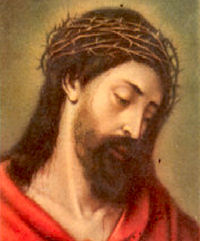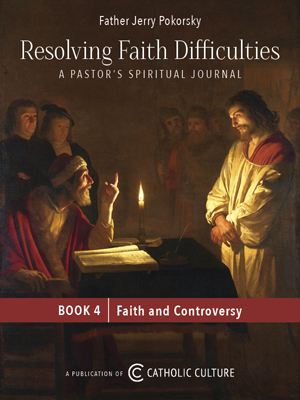Lent: March 13th
Friday of the Second Week of Lent
Other Commemorations: St. Roderick, Martyr (RM); St. Leander of Seville, Bishop (RM);
» Enjoy our Liturgical Seasons series of e-books!
Be merciful, just as (also) your Father is merciful. "Stop judging and you will not be judged. Stop condemning and you will not be condemned. Forgive and you will be forgiven. Give and gifts will be given to you; a good measure, packed together, shaken down, and overflowing, will be poured into your lap. For the measure with which you measure will in return be measured out to you (Luke 6:36-38)."
Meditation
The story of the Prodigal Son is . . . the history of the Church; it is the history of our own desertion. In this Gospel we are given an urgent call to repentance and conversion. "Father, I have sinned." Penance alone can save us. Our Father welcomes us with mercy. The sin and its eternal punishment are forgiven; the good works which we did before sin and the merits which we lost through sin are revived. The Father receives us again as His children, and celebrates a joyful banquet with us at Holy Communion.
In the story of each human life, God's mercy stands on one side and the unfaithfulness of man on the other. Will God have to cast us off as He did the people of Israel? Have we not fully deserved it? Sometimes it appears that God wishes to allow our faithless generation to go its own way. If He does, it will merit a well deserved punishment.
What can save us from rejection? Only penance, self-examination, and conversion. "Be converted to Me with all your heart, in fasting and in weeping and in mourning" (Joel 2:12).
Excerpted from The Light of the World by Benedict Baur, O.S.B.
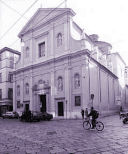
The Station for today is in the church of St. Vitalis, martyr, the father of the two illustrious Milanese martyrs, Sts. Gervasius and Protasius. It was built about 400, and consecrated by Pope Innocent I in 401/2. The dedication to St. Vitalis and his family was given in 412. The church has been rebuilt several times, of which the most comprehensive rebuilding was that of Pope Sixtus IV before the 1475 Jubilee. It was then granted to Clerics Regular.
St. Roderick of Cordoba
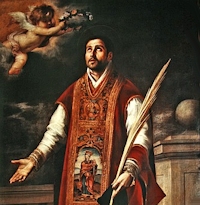 Jesus warned his disciples that they should expect no better treatment than Himself. They would be haled before governors and kings on His account, and brothers would even hand brothers over for execution.
Jesus warned his disciples that they should expect no better treatment than Himself. They would be haled before governors and kings on His account, and brothers would even hand brothers over for execution.
That prophecy was literally fulfilled in the case of St. Roderick, a Spanish martyr who died at the hands of the Muslim Moors in A.D. 857. His was a bitter case of the reverse of Christian love. We owe the account to eyewitness St. Elogius, who later on died for the faith himself.
It must be admitted that when the Mohammedans invaded Spain in A.D. 711, even they were sometimes shocked by the lack of religious principles among a large number of the Hispanic Christians. As the Moors swarmed in, the Catholics, far from presenting a strong front, became divided. Many, whether out of fear or lack of faith, voluntarily gave up their Christianity. Families thus split asunder and the members on either side railed at each other.
St. Roderick was to prove a sad victim of this sort of betrayal. He was a good priest of Cabra who had two irresponsible brothers. One of them was a bad Christian who had all but abandoned his faith. The other had gone still further and joined Islam. One night the two started to fight each other unmercifully. Roderick tried to break them up, but instead of yielding, they turned on him and beat him senseless. Then the Muslim brother had the priest put on a litter and carried half-conscious through the streets. The Muslim accompanied the bier, proclaiming that Father Roderick, too, had apostatized, and that he wanted it known publicly before he died. Eventually the victim did recover and went off to a safe place.
But Father Roderick had not yet seen the last of his renegade brother. The Muslim met the priest soon afterwards in the streets of Cordova. He had Roderick taken at once before the Mohammedan kadi (judge), where he accused him of the crime of having returned to Christianity after public profession of his Muslimism.
Although Father Roderick protested that he had never denied his Christian faith, the kadi clapped him into the city's worst dungeon.
In that fetid jail, the priest at least had the comfort of finding one Solomon, another Christian prisoner who had been accused of the same "unforgiveable" crime. Both of them were given a long term of imprisonment, in the hope that they would convert. But each man encouraged the other, and they remained firm in their Christian convictions. Even when separated, they would not change their belief.
Eventually, the kadi ordered the Catholic priest and the layman beheaded. St. Eulogius saw their headless bodies lying on the riverside. He noticed that the guards were careful to throw into the stream any stones stained with the men's blood, for fear the faithful might pick them up as relics.
The soldiers sought in vain to ward off veneration of SS. Roderick and Solomon. Spanish Christians would always honor them thereafter as martyrs. And they would also gradually learn from this heroism that the Faith is something really worth dying for.
—Father Robert F. McNamara, Excerpted from St. Kateri Tekakwitha Parish
Symbols and Representation: priest in Mass vestments holding a palm of martyrdom as an angel brings him a wreath of roses
Highlights and Things to Do:
- Read more about St. Roderick:
- Read The Islamic Warriors' Destruction of a Nascent Civilization: the Catholic Kingdom of the Visigoths in Spain (A.D. 589–711) which appeared in the Winter-Spring 2011 issue of Modern Age to gain an understanding of the times in which St. Roderick lived.
St. Leander of Seville
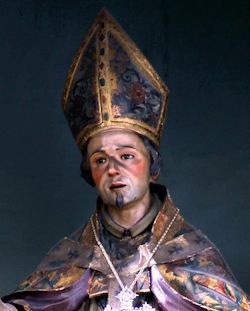 St. Leander was born of an illustrious family at Carthagena in Spain. He was the eldest of five brothers, several of whom are numbered among the Saints. He entered into a monastery very young, where he lived many years and attained to an eminent degree of virtue and sacred learning.
St. Leander was born of an illustrious family at Carthagena in Spain. He was the eldest of five brothers, several of whom are numbered among the Saints. He entered into a monastery very young, where he lived many years and attained to an eminent degree of virtue and sacred learning.
These qualities occasioned his being promoted to the see of Seville; but his change of condition made little or no alteration in his method of life, though it brought on him a great increase of care and solicitude.
Spain at that time was in possession of the Visigoths. These Goths, being infected with Arianism, established this heresy wherever they came; so that when St. Leander was made bishop it had reigned in Spain a hundred years. This was his great affliction; however, by his prayers to God, and by his most zealous and unwearied endeavors, he became the happy instrument of the conversion of that nation to the Catholic faith. Having converted, among others, Hermenegild, the king's eldest son and heir apparent, Leander was banished by King Leovigild. This pious prince was put to death by his unnatural father, the year following, for refusing to receive Communion from the hands of an Arian bishop. But, touched with remorse not long after, the king recalled our Saint; and falling sick and finding himself past hopes of recovery, he sent for St. Leander, and recommended to him his son Recared. This son, by listening to St. Leander, soon became a Catholic, and finally converted the whole nation of the Visigoths. He was no less successful with respect to the Suevi, a people of Spain, whom his father Leovigild had perverted.
St. Leander was no less zealous in the reformation of manners than in restoring the purity of faith; and he planted the seeds of that zeal and fervor which afterwards produced so many martyrs and Saints.
This holy doctor of Spain died about the year 596, on the 27th of February, as Mabillon proves from his epitaph.
The Church of Seville has been a metropolitan see ever since the third century. The cathedral is the most magnificent, both as to structure and ornament, of any in all Spain.
—Excerpted from Lives of the Saints, by Alban Butler, Benziger Bros. ed. [1894]
Patronage: Seville, Spain
Highlights and Things to Do:
- Read more about St. Leander:
- St. Leander was one of several saints in his family. He was the elder brother of Saint Isidore of Seville, Saint Fulgentius of Ecija, and Saint Florentina of Cartagena.
- The Cathedral of Murcia has a silver urn that contains the remains of the four sibling saints.


